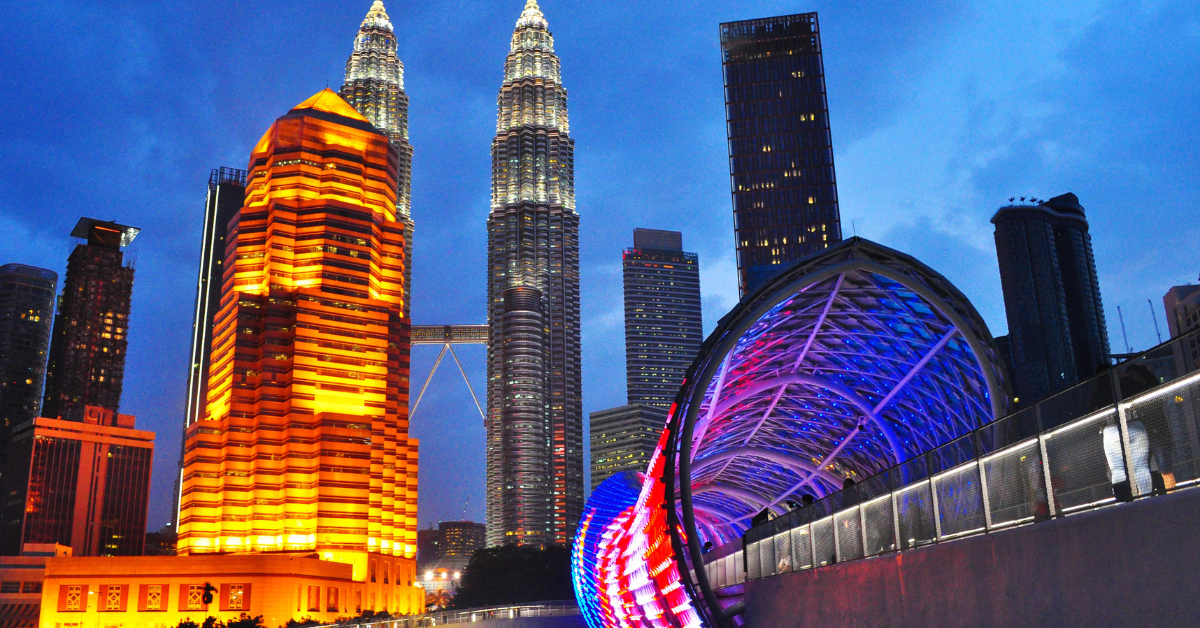Kuala Lumpur, the vibrant capital of Malaysia, is written in Chinese characters as 吉隆坡 (Jílóngpō). This notation originates from a phonetic transcription and is less familiar in Japan, yet it carries auspicious meanings such as prosperity and good fortune. For Japanese people, Kuala Lumpur is more than just a foreign name—it is a city that combines modernity, tradition, and multicultural diversity.
The Chinese Character Notation “吉隆坡” for Kuala Lumpur
Kuala Lumpur’s Chinese character notation is 吉隆坡 (Jílóngpō). It is an example of phonetic transcription, where the characters are chosen for their sounds rather than their meanings. The character 吉 suggests good fortune, 隆 conveys prosperity, and 坡 means slope or hill. Although they do not directly describe the city’s features, together they form a name that implies growth and auspiciousness.
A comparison with other major Southeast Asian cities is shown below.
| City | Chinese Characters | Chinese Pronunciation |
|---|---|---|
| Kuala Lumpur | 吉隆坡 | Jílóngpō |
| Singapore | 新加坡 | Xīnjiāpō |
| Bangkok | 曼谷 | Màngǔ |
| Jakarta | 雅加達 | Yǎjiādá |
This illustrates how Chinese character notation helps with the understanding of place names within the Chinese-speaking world, while also reflecting cultural connections.
Features of Kuala Lumpur as a City
Kuala Lumpur is Malaysia’s political, economic, and cultural hub. The Petronas Twin Towers symbolize modernization, while mosques, temples, and colonial architecture represent its traditions. The coexistence of multiple ethnic groups is one of the city’s defining characteristics.
A summary of the city’s profile is as follows:
| Item | Details |
|---|---|
| Country | Malaysia |
| Chinese Notation | 吉隆坡 |
| Population | About 1.8 million (over 8 million in the metropolitan area) |
| Features | Multicultural city, economic and cultural center |
| Landmark | Petronas Twin Towers |
The Tourist Image of Kuala Lumpur Among Japanese
For Japanese travelers, Kuala Lumpur is often perceived as a “city where you can enjoy yourself at a low cost.” Large shopping malls offer international brands, while food stalls serve Malaysian, Chinese, and Indian dishes at affordable prices.
Key tourist attractions can be grouped as follows:
| Category | Attraction | Characteristics |
|---|---|---|
| Modern City | Petronas Twin Towers | Globally famous skyscrapers |
| History & Culture | Batu Caves | Hindu sacred site |
| Nature | Genting Highlands | Highland resort |
| Urban Space | Merdeka Square | Historic colonial landmark |
The blend of modernity and tradition, urban vibrancy and natural beauty appeals strongly to Japanese visitors.
Kuala Lumpur as a Destination for Relocation and Study
Kuala Lumpur is also popular among Japanese considering relocation or study abroad. English is widely spoken, and the cost of living is lower than in Tokyo, making long-term stays more manageable.
Factors valued by Japanese residents are summarized here:
| Aspect | Japanese Perspective |
|---|---|
| Living Costs | Rent and food are relatively inexpensive |
| Education | Many international school options |
| Transportation | Convenient airport access to the city |
| Culture | A multicultural society that encourages cross-cultural understanding |
These elements make Kuala Lumpur a practical and appealing choice for families, students, and retirees.
Kuala Lumpur as a Business Hub
From an economic standpoint, Kuala Lumpur is increasingly recognized as a gateway to ASEAN. Its geographical advantages make it a hub for multinational corporations. Finance, IT, and the startup ecosystem are thriving, and Japanese companies also regard it as a strategic base for expansion.
Kuala Lumpur from a Sports Perspective
Kuala Lumpur is also a sports city.
- Football (Soccer): The most popular sport nationwide, with national team matches drawing massive crowds.
- Motorsports: The Sepang International Circuit, located nearby, has hosted the Formula 1 Malaysian Grand Prix and continues to host MotoGP races.
- Golf: With high-quality courses both in and around the city, golf is especially popular among Japanese expatriates and tourists.
The city has hosted major events such as the Southeast Asian Games, further enhancing its image as an international sports destination.
Conclusion
The Chinese character notation 吉隆坡 for Kuala Lumpur is based on Chinese phonetic transcription and carries auspicious connotations. The city itself is a reflection of multicultural coexistence, presenting appeal across tourism, lifestyle, business, and sports.
For tourists, it offers diverse cultural and culinary experiences. For expatriates, it provides affordable living and a comfortable environment. For businesspeople, it serves as a promising economic hub. And for sports fans, it is a stage for major international events.
Kuala Lumpur is, and will continue to be, a special city for Japanese people, representing opportunity, discovery, and vibrant diversity.






